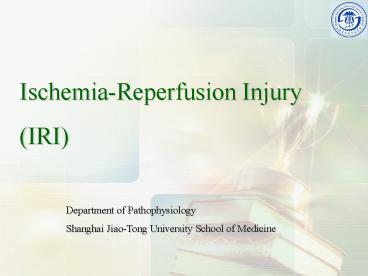Ischemia-Reperfusion Injury - PowerPoint PPT Presentation
1 / 39
Title:
Ischemia-Reperfusion Injury
Description:
Ischemia-Reperfusion Injury (IRI) Department of Pathophysiology Shanghai Jiao-Tong University School of Medicine IRI in other organs The IRI also can occur in other ... – PowerPoint PPT presentation
Number of Views:208
Avg rating:3.0/5.0
Title: Ischemia-Reperfusion Injury
1
Ischemia-Reperfusion Injury (IRI)
Department of Pathophysiology Shanghai Jiao-Tong
University School of Medicine
2
What is ischemia-reperfusion injury?
In majority situations, blood reperfusion
can reduce ischemia-induced tissue and organ
injury, resulting in the structural and
functional recovery. In some circumstances,
however, blood reperfusion may induce or
aggravate the further reversible even
irreversible cell damage and tissue or organ
injury, especially for a prolonged ischemia. This
phenomenon has been termed IRI.
3
(No Transcript)
4
Etiology
5
Factors
6
Experimental study showed
- Calcium paradox
- Oxygen paradox
- PH paradox
7
(No Transcript)
8
Free radicals
Conception and properties
Free radicals are a highly reactive group
of atoms, molecules or radicals, which carry
unpaired electron in out orbital. The properties
of these radicals are as following short life
time and powerful oxidative ability.
9
Classification
- Oxygen free radicals (OFR)
- Nitrogen free radicals (NFR)
- Lipid free radicals (LFR)
- Others chlorine radicals (Cl.), methyl radicals
(CH3.)
10
(No Transcript)
11
- Nitrogen free radicals (NFR)
- Lipid free radicals (LFR)
12
Metabolism of the free radicals
13
(No Transcript)
14
- Scavenge the free radical
15
Mechanisms of free radical increase
16
(No Transcript)
17
- The increase of one electron deoxidization in
mitochondria
18
- The increase of catecholamine and its oxidazition
19
Mechanisms of free radical-induced IRI
OFR are extremely reactive to interact with
lipids, proteins and nucleic acids.
20
(No Transcript)
21
- Intracellular calcium overload
- Protein denaturalization and decreased enzyme
activity
- Nucleic acid damage and chromosome aberration
22
(No Transcript)
23
(No Transcript)
24
Mechanisms of calcium overload-induced IRI
25
Neutrophil activation
It has been manifested that the capillary
damage and dysfunction which mediated by
neutrophil activation play an important role in
IRI.
26
Leukecyte accumulation induced by IRI
27
Mechanism of leukecyte-mediated IRI
- Abnormal regulation of inflammatory reactions
- Machinery blockage action
28
(No Transcript)
29
Myocardial IRI
The major IRI in heart includes arrhythmia,
reversible contractile dysfunction, alterations
of myocardium untrastructure and metabolism.
30
(No Transcript)
31
(No Transcript)
32
Cerebral IRI
Cerebral IRI includes cytotoxic edema and
apoptosis or death of brain, which causes the
manifestation of intracranial hypertension such
as vomiting and coma.
33
(No Transcript)
34
IRI in other organs
The IRI also can occur in other organs
besides heart and brain. For example, liver and
kidney are the organs which studied extensively
in IRI. It has been implicated in the
pathogenesis of a variety of clinical conditions
including trauma, hypovolemic and endotoxic
shock, transplantation, etc.
35
(No Transcript)
36
Control the reperfusion conditions
Shorten the ischemia period
37
Scavenge the free radicals
Relieve calcium overload
Improve the metabolism
38
(No Transcript)
39
Thank You































